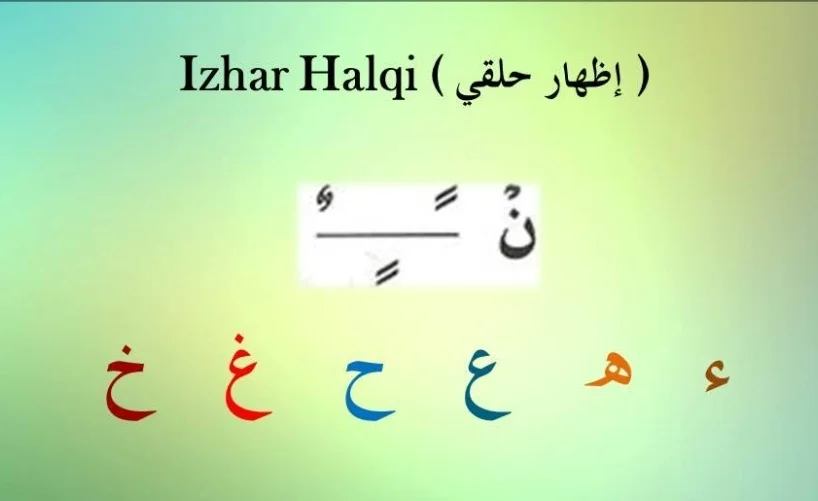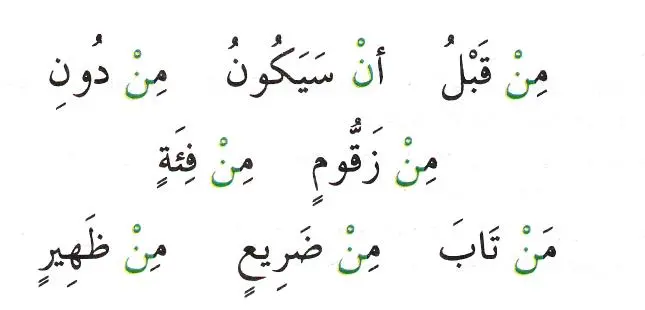izhar letters linguistically, it is the statement, and as a terminology, it is one of the rules of Tajweed that follow the sukoon-nūn and tanween, and it means the sound coming out of the sakon-nun letter or the tanween that precedes one of the Ṣahṭhar letters without a ghannah or something similar attached to it. Below we will discuss the letters of izhar and what is related to them in detail.
What is the definition of al izhar tajweed?
izhar letters linguistically means: clarification and clarity. As for the definition of letters of izhar idiomatically according to Tajweed scholars, it is: one of the rulings on the noon sakinah and tanween, which is to bring out the letter from its exit without an extra ghana.

The al izhar tajweed of the noon sakinah and tanween is called the izha halqi; This is because all of its six letters emerge from the throat exit
What is al izhar tajweed characters and its description?
izhar letters are; the hamza. haa. Ein. H. Ghin. The kha. As for the characteristic of the apparent appearance in the Noble Qur’an, it is: that the sukoon or tanween comes and then one of the six throat letters comes after it.
The scholars have set this ruling as follows: establishing the sukoon on the nun and not stressing the next letter. As for tanween, it sets a compound tanween without stressing the following letter.
What is the reason for Izhar?
letters of izhar is the first rule of the rulings of the Sakinah Nun and Tanween, and the rulings of the Sakan Mim as well. al izhar tajweed is known linguistically: that it is clarification and clarity, and it is also known idiomatically: that it is taking out each of the letters of izhar from its origin without any accentuation in the letter that is intended to be made manifest.

And there are many types of al izhar tajweed, such as the Izhar halqi. Which is in the Nūn and Tanween, izhar moutluk which is only in the Sakinah Nūn, Izhar shafawi which is in the Sakinah Mīm, and also the Lam-Al manifestation; That is, the definition
The main reason for pronouncing the ruling on the al izhar tajweed is the authentic narration from the Prophet, may Allah bless him and grant him peace. Tajweed scholars have explained the reason for Izhar halqi by the spacing between the exit of the izhar letters.
Which emerge from the throat farthest from the lips, and the exit of the noun sakina and tanween, which emerge from the tip of the tongue with what is adjacent to it. From the gums of the upper teeth.
The spacing between the exits of the letters prevents their assimilation. The reasons for assimilation are either similarity, homogeneity, or closeness, and due to the absence of these reasons, the ruling between these letters is assimilation.
Types of Izhar
One of the most important things that helps in reading the Qur’an with correct pronunciation is learning the rules of Tajweed and al izhar tajweed of all types, as there are several types of al izhar tajweed, which are:
1-izhar shafawi
This type is limited to the letter meem, which is in a static state. We find that all letters in the Arabic language that come after the silent meem must be shown, except for the letters meem and b. When they are attached to the silent meem, we must hide them.
2-izhar halqi
The letters of izhar are limited to E, H, A, G, H, and Kh, which are the letters that must be pronounced in pronunciation when they come after the noun sakun or tanween. They are given this name because they depend on the throat in pronunciation.
3-izhar moutluk
This type of letters of izhar depends on highlighting the sakina nun that comes before the letters waw and yaa. That is, the sakina nun must be made clear when pronouncing it in order to give the correct meaning of the word.
Pronunciation does not depend on the throat or anything else. Also, the sakina nun must not be assimilated with the letters waw and yaa so that it does not The meaning of the word changes
What are the levels of izhar?
There are three ranks of al izhar tajweed for the throat manifestation, depending on the distance between the exit of the letter throat and the exit of the nun, and they are as follows:
- The maximum rank is at the letters hamza and ha, as they emerge from the farthest part of the throat.
- The middle level is at the letters Ain and Ha, where they emerge from the middle of the throat.
- The lowest rank is at the letters ghān and kha, as they emerge from the lowest throat.
What is the difference between Idgham and Izhar halq?
Idgham is a language: insertion, and assimilation is the insertion of the sukoon nūn or tanween with the assimilation letters that follow it, which are grouped in the word (يرملون).
Idgham with a ghannah differs from a throat accent in the amount of ghannah. As the ghannah in idgham with ghannah is complete in the amount of two movements, while in the ghannah it is not apparent in the amount of two movements.
Also, the term for controlling the full idgham is by stripping the first and stressing the second, while in al izhar tajweed it is by placing a small haa head above the sakun noon and replacing the second vowel in the tanween while not stressing the second. The tanween in idgham is sequential, while in al izhar tajweed, the tanween is complex.
🌟 Master the Art of Quranic Recitation!
Unlock the secrets of perfect pronunciation with our comprehensive guide to Idgham rules. Whether you’re a beginner or seeking to refine your recitation, understanding these essential merging rules will transform your Quran reading.
Ready to elevate your Tajweed journey? Dive into the world of Idgham rules today and experience:
- Crystal-clear pronunciation
- Confident recitation
- Deeper connection with the Quran
➡️ Click now to explore our Idgham rules guide and take your Quranic recitation to the next level!
What is the difference between Izhar haqi and ikhfa haqiqi?
The ikhfa haqiqi means concealing the sakina nūn or the tanwīn nūn when they meet the letters of concealment, The guttural appearance of the ghunnah in it is not apparent for the amount of two vowels, but in al izhar tajweed the ghunnah is apparent in two movements.
What is the difference between Izhar halqi and Iqlab?
The meaning of the iqlab is to turn the sakina nūn or the tanwīn nūn into a hidden meem when it meets the letter b with a ghannah of two vowels, and the ghannah is for the hidden meem and not for the sakīnah nūn, like the Almighty’s saying:
{سَمِيعٌ بَصِير}
The term for adjusting al izhar tajweed is by placing the small “ha” head above the sakina nūn and stripping the second letter, while in the inversion, it is by placing a small pendant meem above the saknian nūn and replacing the second movement of the tanween with stripping the b.
What is the difference between Izhar halqi and Izhar mutluk?

There are many differences between al izhar tajweed, and they are as follows:
1-The difference between them is in terms of definition
- In addition to izhar letters, Izhar halqi is known as: It is the protrusion of the six letters of the throat from their origin without a visible ghanna with the letter that appears.
- As for the Izhar mutulk: It is the protrusion of one of the assimilation letters waw or yaa when they are combined with the nun in one word. Without any apparent weakness in the apparent letter.
2-The difference between them is in terms of naming
- The Izhar halqi is called annular; Because all of its letters come out of the throat.
- As for the Izhar mutulk, it is called absolute in order to differentiate between it and the declarative, oral, and lunar types. The difference between them in terms of letters is the cyclic manifestation, which has six letters.
- As for Izhar mutulk; Its letters are the waw and the yaa, and they are diphthongs.
3-The difference between them is in terms of image
- The Izhar halqi comes in more than one form; It comes in one word or two words, for each of its letters, whether the letter is after the noon sakinah or the tanween.
- As for the Izhar mutulk, it only comes in one word, after the noon sakenah only.
4-The difference between them is in terms of ranks
- The Izhar halqi has three levels: It is according to its letters and its directory; The first rank is the highest at the hamza and ha, the second rank is the middle at the ayn and the ha, and the third rank is the lowest at the ghān and kha.
- As for the Izhar mutulk, it has no levels or anything like that.
The difference between them is in terms of cause
The reason for Izhar halqi is distance; That is, the letter Nūn is far from the six letters of the throat, which emerge from one of the three parts of the throat. It certainly did not improve the assimilation, nor did he improve the concealment either.
Discover the Secret Rhythm of Arabic: Master Qalqalah Letters Today!
Want to perfect your Quranic recitation? The bouncing sounds of qalqalah letters hold the key to beautiful Arabic pronunciation. Learn how these special letters—ق ط ب ج د—create that distinctive echo that brings Arabic to life.
Join our masterclass and unlock:
- The 5 essential qalqalah letters you must know
- Simple techniques to recognize and pronounce them
- Practice exercises to build your confidence
- Expert tips from qualified instructors
Don’t let these vital letters stand between you and proper recitation. Click now to start your journey with qalqalah letters and transform your Arabic pronunciation!
Conclusion
In conclusion, izhar letters is one of the rules of the Nun Sakinah and Tanween, and the letters of izhar comes in three types that we mentioned in detail within the paragraphs of our article. In addition, we mentioned the differences between al izhar tajweed and the other rulings of Nun Sakinah.
Empower Your Children’s Islamic Education with Online Arabic Learning
Give your children the gift of understanding the Quran through al hafidz academy‘s comprehensive online learning programs. Our courses are designed for both children and adults, making Arabic language and Quran studies accessible to everyone, regardless of their native language.
What We Offer:
- Interactive Arabic classes for children
- Adult Quran learning programs
- Tajweed (proper pronunciation) instruction
- Islamic Studies curriculum
- Tafsir (Quranic interpretation)
- Various Qirat styles
- Ijazah certification programs
Why Choose al hafidz academy?
- Experienced and friendly Quran teachers
- Engaging eLearning platform
- Structured yet enjoyable lessons
- Personalized attention
- Flexible scheduling options
Our qualified instructors create a welcoming environment where students can develop a deep connection with the Holy Quran. The user-friendly platform makes learning enjoyable and effective, allowing students to progress at their own pace while maintaining high educational standards.
Start your family’s journey in Quranic education today with our experienced teachers who are dedicated to nurturing your children’s spiritual and educational growth.
